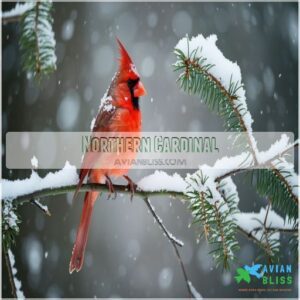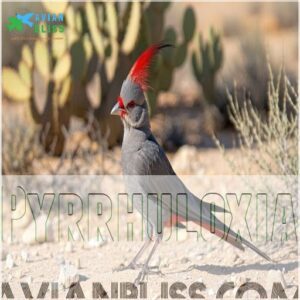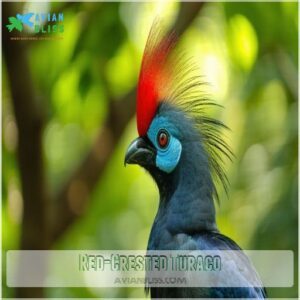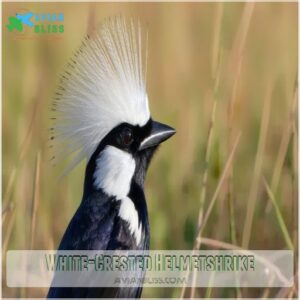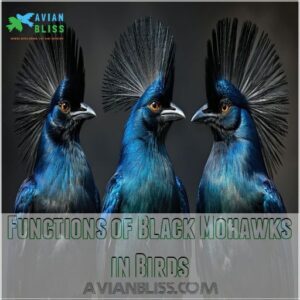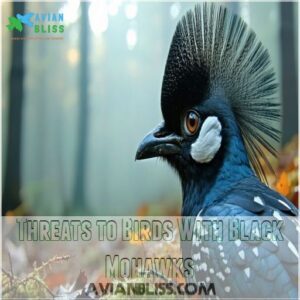This site is supported by our readers. We may earn a commission, at no cost to you, if you purchase through links.

Birds like the Steller’s Jay flaunt a bold black crest paired with dazzling blue feathers, while the Pileated Woodpecker struts a dramatic black and red combo.
These mohawks aren’t just for show; they help with mate attraction, communication, and even camouflage.
Species range widely, from the Northern Cardinal, with its sleek accent of black, to the Cedar Waxwing, sporting a smooth black crest and mask.
Found globally, these birds inhabit diverse areas like North American forests and African savannas.
Ready for more surprising feathered features? Keep exploring!
Table Of Contents
- Key Takeaways
- Birds With Black Mohawks Overview
- Types of Birds With Black Mohawks
- Birds With Black Mohawks by Region
- Birds With Black Mohawks and Other Distinctive Features
- Functions of Black Mohawks in Birds
- Birds With Black Mohawks in Captivity
- Birds With Black Mohawks in The Wild
- Threats to Birds With Black Mohawks
- Conservation Status of Birds With Black Mohawks
- Interesting Facts About Birds With Black Mohawks
- Frequently Asked Questions (FAQs)
- What birds have mohawks?
- Which bird has the best Mohawk?
- Why do some birds use Mohawks?
- What does a Mohawk look like?
- What is a black and white hornbill with a Mohawk?
- How do Mohawk birds get their name?
- Where Do Royal Flycatchers Live?
- What Is The Bird With A Yellow Mohawk?
- What Bird Has An Orange Mohawk?
- What kind of bird has a black mohawk?
- Conclusion
Key Takeaways
- You’ll find birds with black mohawks around the globe, from North American forests to African savannas, showcasing their adaptability to diverse habitats.
- These mohawks aren’t just for show—they’re used for mate attraction, communication, camouflage, and even thermoregulation.
- Iconic species include the Palm Cockatoo, Steller’s Jay, and Pileated Woodpecker, each flaunting unique crests with bold styles.
- Threats like habitat loss, climate change, and poaching put these birds at risk, making conservation efforts crucial for their survival.
Birds With Black Mohawks Overview
Black mohawks in birds are a fascinating feature.
They vary widely in size, shape, and function across species.
You’ll find these striking crests on birds from diverse habitats around the world.
From dense forests to open savannas, black mohawks are a fascinating feature.
Characteristics of Black Mohawks
The black mohawks on birds are a true spectacle, showcasing variety in size, texture, and purpose. These feathered crests can appear sleek or bushy, spiky or smooth, giving each species its unique flair. From the regal Grey Crowned Crane to the bold Steller’s Jay, mohawk birds embody style and functionality. Many enthusiasts even showcase their love for these birds through unique black mohawk bird accessories Black Mohawk Gifts.
- Size Variations: Some crests are compact, others grand and imposing.
- Feather Texture: Crests range from soft, flowing feathers to rigid, spiky displays.
- Seasonal Changes: Mohawks may look different during breeding seasons.
These crests aren’t just for show—they aid in courtship, communication, and camouflage.
Variations in Black Mohawk Shapes and Sizes
Bird mohawks come in all shapes and sizes, from sharp spikes to smooth, cascading plumes.
Mohawk length and crest shape in black mohawk birds often reflect their personality—think bold feathers for confident species or sleek designs for stealthy ones. Feather texture varies too. Some species sport soft crests, while others showcase stiff, attention-grabbing structures.
Here’s a quick breakdown:
| Feature | Example Birds | Attribute |
|---|---|---|
| Mohawk Length | Palm Cockatoo | Long, dramatic |
| Crest Shape | Great Curassow | Curly and compact |
| Feather Texture | Victoria Crowned Pigeon | Smooth and elegant |
| Iridescence | Pileated Woodpecker | Glossy black highlights |
Mohawk birds truly flaunt nature’s creativity!
Geographic Locations of Birds With Black Mohawks
From dense forests to open savannahs, black mohawk birds thrive globally.
Steller’s Jays dominate western North America, while habitat maps reveal Oak Titmouse’s preference for California oak woodlands.
Migration patterns highlight range shifts among avian species.
Endemic species like the Victoria Crowned Pigeon favor conservation areas, ensuring these striking birds with crests endure.
The unique bird mohawk anatomy, also known as crests formed by feathers, serve essential functions beyond aesthetics.
Types of Birds With Black Mohawks
You’ll find an incredible variety of birds sporting black mohawks.
Each with its own unique flair.
From the striking Pileated Woodpecker to the subtle charm of the Cedar Waxwing, these species showcase just how diverse and fascinating head crests can be.
Northern Cardinal
Have you noticed how Northern Cardinals always grab attention? Though famous for vivid red feathers, their tiny black "mohawk" adds flair. They’re a hit for their melodies, sturdy nests, and flair-filled "hairstyles." Curious? Here’s why they’re special:
- Cardinal Songs: Soulful and versatile.
- Feisty: Defends bold patches/barriers.
Pileated Woodpecker
The Pileated Woodpecker, a black crested bird with a fiery red mohawk, thrives in forested habitats.
Known for deep tree excavations while hunting ants, its loud calls and rhythmic drumming stand out.
Though bold in appearance, it’s surprisingly elusive.
Conservation focuses on preserving large, dead trees essential for its nesting needs.
Steller’s Jay
Steller’s Jays are bold black-crested birds with vivid blue plumage and a slick mohawk that screams personality.
Found in western pine forests, these clever crested birds thrive on seeds, insects, and occasional snacks they’ve swiped.
Known for their varied Stellers Jay calls, they’re vocal socialites whose antics and striking looks make them unforgettable stars among birds with mohawks.
Cedar Waxwing
Cedar Waxwings are sleek, mohawked bird species with bold crested feathers and a striking black mask.
These berry-loving birds gorge on fruit, often passing pieces mid-flight to their flock mates.
Found in forests and gardens, their Waxwing calls are soft and high-pitched, complementing elegant red wingtips and yellow-tipped tails during Waxwing migration.
Pyrrhuloxia
If you’re into bird species with crests, the Pyrrhuloxia—nicknamed the "desert cardinal"—is a standout. This mohawked bird species flaunts gray plumage and a red-tipped crest.
Found in the Pyrrhuloxia habitat of southwestern deserts, it thrives on:
- Seeds and insects
- Iconic Pyrrhuloxia songs
- Drought-resistant strategies
- Sparse desert scrub
- Conservation-focused areas
Its bold look hides growing Pyrrhuloxia threats.
Birds With Black Mohawks by Region
You’ll discover an incredible array of birds sporting black mohawks across different continents.
From the dense forests of Africa to the tropical regions of Asia.
These unique feathered creatures showcase nature’s remarkable diversity.
each region offering its own distinctive species that sport these striking head crests.
North American Birds With Black Mohawks
Breaking through forest silence, North American birds with black mohawks command attention. The Steller’s Jay and Tufted Titmouse reign supreme, their distinctive crests signaling intelligence and survival.
The intelligence of birds like the American Crow, known for its problem-solving abilities, is often linked to their unique physical characteristics and adaptations, such as the Steller’s Jay’s crest, as seen in common backyard birds.
| Bird Species | Mohawk Color | Habitat |
|---|---|---|
| Steller’s Jay | Black | Coniferous Forests |
| Tufted Titmouse | Gray | Woodland Areas |
| Pileated Woodpecker | Black | Mixed Forests |
| Northern Cardinal | Black-Red | Diverse Landscapes |
| Black-capped Chickadee | Black | Woodland Edges |
Their mohawk feathers aren’t just for show—they’re survival tools that speak volumes about adaptation and resilience.
South American Birds With Black Mohawks
After North America’s feathered mohawk mavens, South America takes center stage with its own black-crested rockstars. Rainforest dwellers like the Great Curassow, Royal Flycatcher, and Crested Duck showcase nature’s wild hairstyles:
- Survival fashion statements
- Courtship display masters
- Endangered ecosystem indicators
These avian rebels sport black mohawks that scream freedom, turning tropical landscapes into living runways of evolutionary creativity.
African Birds With Black Mohawks
Explore Africa’s black-mohawked avian wonders, where three standout species showcase nature’s most dramatic head feathers, and for those looking to learn more about these unique birds, African bird mohawks are truly a sight to behold.
| Bird Species | Mohawk Characteristic | Habitat |
|---|---|---|
| Bare-faced Go-away Bird | Large gray-black crest | African woodlands |
| White-crested Helmetshrike | Spiky white mohawk | Woodland regions |
| Great Blue Turaco | Prominent black crest | Central African forests |
| Red-crested Turaco | Vibrant red mohawk | Sub-Saharan landscapes |
| Grey Crowned Crane | Stiff hair-like feathers | Eastern/Southern Africa |
These feathered rebels rock their black mohawks like living art, turning heads and defending territories with style.
Asian Birds With Black Mohawks
From the grasslands of Africa to the diverse landscapes of Asia, mohawk-styled birds continue their enchanting journey.
Your exploration of Asian black-crested birds reveals fascinating insights about these feathered fashionistas.
Check out these mohawk marvels:
- Red-vented Bulbul: Native across South Asia, sporting a distinctive crest
- Introduced species with remarkable adaptability
- Some considered agricultural pests in non-native regions
- Unique avian hairstyles that showcase nature’s creative design
Birds With Black Mohawks and Other Distinctive Features
You’ll be amazed by the diversity of birds sporting striking black mohawks, each with its own unique flair.
From the elegant Victoria Crowned Pigeon to the vibrant Purple-Crested Turaco, these feathered fashionistas showcase nature’s incredible design and adaptability.
Victoria Crowned Pigeon
Meet the Victoria Crowned Pigeon, a living masterpiece of avian hairstyles strutting through New Guinea’s forests. This regal bird rocks a lace-like mohawk that’d make any runway model jealous.
It uses its impressive head feathers for Bird Communication, broadcasting its presence to other birds and potential mates.
- Near Threatened due to shrinking habitats
- Feasts on fallen forest fruits
- Mates for life with stunning commitment
Your wild bird crush just got an upgrade.
Purple-Crested Turaco
After studying the crowned pigeons, prepare to meet another African treetop gem: the Purple-Crested Turaco.
Sporting a regal purple mohawk that screams wild beauty, these birds rock vibrant green plumage punctuated by stunning crimson wing panels.
Native to sub-Saharan landscapes, they’re nature’s living artwork, munching fruits and broadcasting loud calls that echo through dense forest canopies.
Red-Crested Turaco
Step into the realm of the Red-crested Turaco, a vibrant bird that rocks an impressive mohawk in the lush forests of Angola. These social butterflies flock together, painting the treetops with their distinctive calls and colorful plumage.
- Electrifying red mohawk crowns its head
- Pierces through forest canopies with distinctive sounds
- Thrives in tight-knit social groups
- Feasts on a smorgasbord of forest fruits
- Conservation efforts keep this spectacular species flying high
Grey Crowned Crane
Standing tall with a regal golden crown, the Grey Crowned Crane captivates wildlife enthusiasts across sub-Saharan Africa.
These majestic birds perform intricate crane dances, showcasing unique calls that echo through their vulnerable habitats.
Conservation efforts aim to protect these extraordinary crested bird species from the growing threat of habitat loss.
White-Crested Helmetshrike
Ready to meet the white-crested helmetshrike, nature’s social butterfly? These African savanna dwellers rock a stunning white mohawk that’ll make you look twice.
Check out their incredible world:
- Spider-web nest architects
- Tight-knit family groups
- Caterpillar and moth hunting experts
- Lifelong pair bonding
- Vocal communication masters
Their distinctive white crest isn’t just for show—it’s a beacon of survival, signaling group cohesion and territory boundaries in the wild. Talk about wearing your personality on your head!
Functions of Black Mohawks in Birds
Have you ever wondered why birds sport those striking black mohawks that seem to serve more than just a fashion statement?
These distinctive head feathers play vital roles in bird survival.
communication, mate attraction, territorial defense, and even helping birds regulate their body temperature in challenging environments.
Attracting Mates
Frequently, birds with black mohawks leverage their striking head feathers as powerful mating signals.
These dramatic crests become nature’s billboard, advertising genetic fitness through elaborate courtship displays.
Pileated Woodpeckers, for instance, transform head-bobbing into an art form, using their distinctive mohawks to catch a potential mate’s eye.
The bolder the crest, the more attractive the bird becomes – a visual symphony of health, vigor, and reproductive potential that speaks volumes in the wild’s complex mating marketplace.
Communication
Communication isn’t just chirps for birds with mohawks—it’s a symphony of body language.
Their distinctive crests serve as dynamic signaling tools, broadcasting intricate mating rituals and alarm signals.
By raising, lowering, or flattening their head feathers, these avian communicators convey complex messages that transform simple interactions into nuanced dialogues of survival and connection.
Territory Disputes
Ever wondered how birds defend their turf? Black mohawk-sporting birds release powerful territorial displays that rival nature’s most intense power struggles.
Here’s how they assert dominance:
- Raise crest feathers to appear larger
- Use aggressive posturing and vocalizations
- Perform strategic aerial confrontations
- Engage in physical pecking and chasing
- Mark boundaries through strategic positioning
Their territorial defense mechanisms can also be influenced by their habitat and environment, such as Crested birds in urban areas.
These defense mechanisms protect mating rights and critical resources in their habitats.
Camouflage
Clever black mohawks serve as nature’s ultimate disguise for birds traversing dangerous landscapes.
These distinctive crests transform predation risks into survival advantages through remarkable camouflage techniques:
- Break up the bird’s predictable body outline
- Match complex forest shadow patterns
- Create visual disruption against natural backgrounds
Your mohawk isn’t just a fashion statement—it’s a lifesaving adaptation against hungry predators.
Thermoregulation
Managing body heat takes serious skill for birds with black mohawks.
Their distinctive feather structures act like natural thermal regulators, helping them adapt to challenging climates.
By strategically using their crests during sunning behaviors, these birds minimize heat loss and maximize insulation, often seeking products like bird mohawk heat accessories.
Their plumage isn’t just a fashion statement—it’s a sophisticated survival mechanism that keeps them thriving in diverse environments.
Birds With Black Mohawks in Captivity
If you’re fascinated by birds with striking black mohawks, you’ll find that many of these unique species thrive in captivity.
as popular pets and conservation ambassadors.
From the Palm Cockatoo to the Cockatiel, these feathered friends capture our imagination.
and play significant roles in breeding programs and public education about avian diversity.
Domestication of Birds With Black Mohawks
Selectively domesticating birds with mohawks demands careful navigation through complex ethical landscapes. Your journey into breeding these unique feathered rockstars involves understanding their wild essence while maintaining genetic diversity.
- Preserve natural behavioral patterns
- Minimize stress through habitat simulation
- Maintain genetic variability
- Develop specialized nutritional strategies
- Implement careful breeding protocols
Researchers face significant challenges when transferring birds with mohawks from wild environments to controlled settings. Each species requires a nuanced approach that respects their original communication systems and territorial instincts. By prioritizing the birds’ natural characteristics, you’ll create more sustainable and humane domestication practices that honor their distinctive crest-bearing heritage.
Popular Pet Birds With Black Mohawks
Crested companions like cockatiels and green-cheeked conures turn heads with their distinctive black mohawks.
These sociable birds demand dedicated owners ready to provide spacious homes, continuous interaction, and specialized care.
However, researching birds you can keep with budgies before introducing them to your aviary is critical.
Their unique features and playful personalities make them standout pets for bird enthusiasts seeking an extraordinary feathered friend.
Conservation Efforts for Birds With Black Mohawks
The winged warriors of the mohawk world are fighting an uphill battle against extinction. Conservation heroes are mobilizing to protect these feathered icons through critical strategies:
- Funding needs drive captive breeding programs for vulnerable species
- Habitat restoration projects rebuild critical ecosystems
- Community involvement empowers local wildlife protection efforts
- Public awareness campaigns educate global audiences about endangered birds with mohawks
Your support can transform these birds’ survival narrative from precarious to promising.
Birds With Black Mohawks in The Wild
You’ll discover fascinating birds sporting jet-black mohawks.
These distinctive feathered creatures thrive in diverse wild habitats across continents.
From the dense forests of Africa to the lush rainforests of South America, they showcase remarkable adaptations.
These adaptations help them survive and thrive in their unique ecosystems.
Habitat and Distribution of Birds With Black Mohawks
Ever wondered where birds with black mohawks call home?
These feathered mavericks roam diverse landscapes, from dense woodpeckers’ forests to backyard feeders.
Their geographic range spans freshwater habitats, northeastern woodlands, and beyond, proving their incredible adaptability and survival skills.
Behavior and Social Structure of Birds With Black Mohawks
Maverick black-mohawked birds dance to nature’s wild rhythm.
Their flock dynamics pulse with energy, communicating through piercing calls and subtle feather signals.
Complex mating rituals and territorial displays weave intricate social tapestries.
Parental care runs deep, with synchronized defense strategies.
Seemingly chaotic groups transform into unified, resilient communities.
Diet and Foraging Habits of Birds With Black Mohawks
Soaring beyond social connections, birds with black feathers reveal unique foraging techniques that’ll blow your mind.
Each species crafts a culinary adventure suited to survival:
- Seeds and insects fuel Steller’s Jays
- Chickadees masterfully hunt suet and small prey
Their dietary variations showcase nature’s incredible adaptability, transforming seasonal challenges into mouthwatering meals across diverse landscapes.
Threats to Birds With Black Mohawks
You’ll be shocked to learn that birds with black mohawks face numerous threats in their natural habitats.
These unique species are struggling with challenges like habitat destruction, climate change, hunting pressures, and increasing disease risks.
that could dramatically reduce their populations.
Habitat Loss and Fragmentation
Imagine your neighborhood suddenly vanishing, piece by piece.
That’s the harsh reality for black mohawk birds facing habitat fragmentation.
Forests shrink, landscapes fragment, and these unique species find themselves squeezed into smaller, disconnected spaces.
Conservation strategies like wildlife corridors offer hope, creating lifelines that reconnect essential habitats and give these feathered survivors a fighting chance.
Hunting and Poaching
As habitat loss shrinks bird territories, poachers target species with black mohawks, exploiting their unique beauty for illegal wildlife trade.
These striking birds face grave risks from hunters seeking rare feathers and exotic specimens.
Strong anti-poaching strategies and community-driven conservation efforts are essential to protecting vulnerable bird populations from extinction.
Climate Change
When climate change barges into bird habitats, it disrupts more than just scenery. Black mohawk-sporting birds face unprecedented challenges:
- Migration routes become unpredictable
- Breeding territories shrink dramatically
- Temperature fluctuations threaten reproductive cycles
- Survival strategies demand rapid transformation
These crested survivors must adapt or risk vanishing, pushing conservation efforts to the brink of urgent action.
Disease and Parasites
Seven parasitic challenges threaten birds with black mohawks, turning their lives into a microscopic battleground.
Disease prevention requires understanding their unique vulnerabilities.
| Parasite Type | Host Impact | Treatment Method |
|---|---|---|
| Feather Mites | Plumage Damage | Topical Medication |
| Intestinal Worms | Nutritional Loss | Antiparasitic Drugs |
| Blood Parasites | Immune Suppression | Targeted Antibiotics |
| External Lice | Skin Irritation | Specialized Cleansing |
| Fungal Infections | Respiratory Issues | Antifungal Treatments |
Wildlife health demands vigilant, proactive intervention.
Conservation Status of Birds With Black Mohawks
You’ll discover that many birds sporting distinctive black mohawks face significant conservation challenges.
These challenges are due to habitat loss, climate change, and human activities.
Understanding their conservation status can help you appreciate the critical role these unique species play in maintaining ecological balance and biodiversity.
Endangered and Vulnerable Species
You’ll quickly spot birds with black mohawks hanging on by a thread in the conservation world. Their survival hinges on critical challenges:
- Habitat destruction carving up their living spaces
- Poaching threatening rare bird populations
- Climate shifts disrupting breeding patterns
- Invasive diseases targeting vulnerable species
These birds dance on the razor’s edge of extinction, demanding urgent protective strategies.
Habitat protection is essential, with conservation efforts like captive breeding programs offering hope for these feathered friends.
Conservation Efforts and Organizations
Because black mohawk bird conservation demands innovative approaches, organizations are tackling critical challenges through strategic partnerships.
Conservation networks leverage funding sources to protect vulnerable species, focusing on habitat restoration and community-driven initiatives.
Successful programs monitor population trends, develop targeted breeding strategies, and engage local communities.
By addressing conservation challenges collaboratively, these efforts aim to safeguard unique bird species with distinctive mohawk-like crests from potential extinction.
Role of Humans in Conservation
Wildlife conservation of black mohawk bird species hinges on human commitment.
Your actions can transform their survival trajectory through strategic engagement:
- Participate in citizen science monitoring programs
- Support habitat restoration initiatives
- Fund research and breeding conservation efforts
- Educate local communities about endangered bird species
Every individual contribution creates a ripple effect in protecting these remarkable crested feathered friends.
Interesting Facts About Birds With Black Mohawks
If you’re fascinated by birds with distinctive black mohawks, you’re in for a treat with these remarkable feathered creatures.
These unique avian species showcase incredible adaptations.
incredible adaptations that’ll surprise you with their evolutionary ingenuity, from communication strategies to mate attraction techniques.
Unique Characteristics and Adaptations
Nature’s black mohawk masters showcase more than style—they’re survival artists.
From Steller’s Jays’ intricate communication to Pileated Woodpeckers’ rhythmic tree-drumming, these crested birds deploy unique sensory adaptations.
Their bold feather variations serve critical flight dynamics, predator evasion strategies, and mate attraction signals, transforming a simple head covering into a complex survival toolkit.
Cultural Significance of Birds With Black Mohawks
Birds with black mohawks carry deep cultural value, often linked to spiritual beliefs and seen in folklore stories across diverse traditions.
These unique bird species inspire:
- Indigenous symbolism – Power and freedom through bold crests.
- Artistic depictions – Hairstyles mimic striking bird crowns.
- Modern interpretations – Represent edgy style and fierce independence.
Fun Facts and Trivia About Birds With Black Mohawks
These crested birds carry more than style—black mohawks symbolize power, stealth, and wisdom.
Pileated Woodpeckers and Steller’s Jays flaunt their crests for mate attraction or to appear bigger for predators.
Some birds with mohawks, like the Eurasian Hoopoe, coat feathers with foul-smelling oil for protection.
Their quirky bird calls and unique diets complete their standout charm.
Frequently Asked Questions (FAQs)
What birds have mohawks?
You’ve got striking birds with mohawks everywhere!
Think Palm Cockatoos with bold black crests, Great Curassows flaunting curly black crowns, and Victoria Crowned Pigeons rocking elegant, lacy crests.
Each stands out with mohawks that truly impress.
Which bird has the best Mohawk?
Imagine a rock star with feathers—the Palm Cockatoo takes the crown.
Its smoky-black mohawk, combined with fiery red cheek patches and drumming displays, oozes charisma.
making it the ultimate bird with attitude.
Why do some birds use Mohawks?
Birds use mohawks to attract mates, intimidate rivals, or as a visual signal tied to their behavior or habitat.
A striking crest might scream, “Look at me!”
or signal confidence during courtship or territorial disputes.
What does a Mohawk look like?
A mohawk resembles a dramatic crest of feathers or hair rising sharply from the center of the head.
It’s often tall, spiky, or swept back.
It evokes the bold assertiveness of both birds and punk rockers.
What is a black and white hornbill with a Mohawk?
The Black-and-white-casqued Hornbill features a striking mohawk-like crest of feathers on its head.
It’s native to Africa, with bold black and white plumage, a large casque atop its bill, and loud, resonating calls.
How do Mohawk birds get their name?
Mohawk birds earn their name from their dramatic, crest-like feathers resembling the iconic human hairstyle.
These crests, often used for display or communication, add flair to their appearance and help them stand out in nature.
Where Do Royal Flycatchers Live?
About 90 species from Central and South America call the Royal Flycatcher’s home.
They thrive in tropical forests and woodlands.
They favor lowland areas near rivers and streams, often displaying their vibrant crests during courtship.
What Is The Bird With A Yellow Mohawk?
You’re probably thinking of the Sulphur-Crested Cockatoo.
It flashes a bright yellow mohawk, standing out against its white feathers.
Found in Australia and New Guinea, this clever bird is both beautiful and notoriously mischievous.
What Bird Has An Orange Mohawk?
A flash of fiery brilliance, the Golden Pheasant steals the show with its bright orange mohawk.
Native to China’s forests,
it pairs this striking crest with a vibrant red body and golden cape.
What kind of bird has a black mohawk?
Some birds rock black mohawks, like the Palm Cockatoo with its bold smoky crest.
The Great Curassow flaunting curly black feathers.
The Tufted Titmouse adds charm with its compact gray mohawk.
Conclusion
Picture a concert in the wild where birds with black mohawks steal the show, flaunting their bold crests and vibrant personalities.
From the flashy Steller’s Jay to the striking Pileated Woodpecker, their unique feathers serve brilliant purposes like attracting mates, communicating, or blending into their surroundings.
Whether soaring over North American forests or perched in African savannas, they balance beauty with function.
Appreciate these rock-star birds—they’re essential to ecosystems and reminders of nature’s extraordinary designs.


